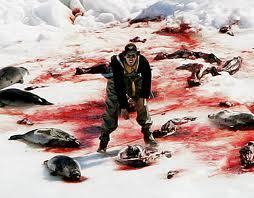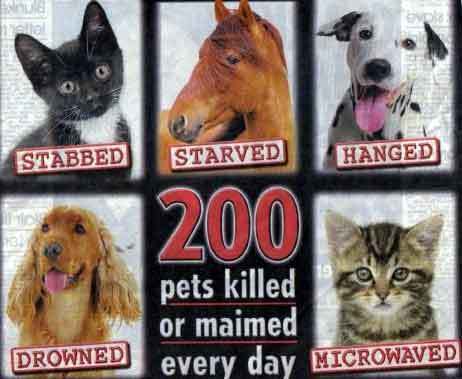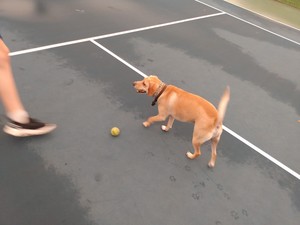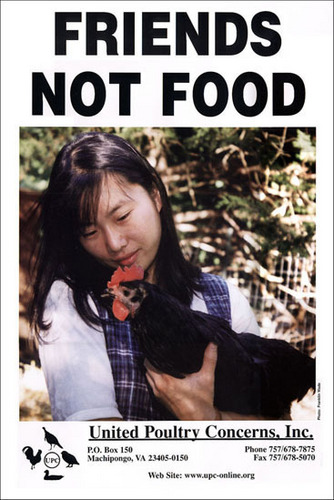For more than a century, humans have deliberately pitted dog-aggressive dogs who will instinctively give their all in staged fights against one another. Why are animal welfare advocates no closer to ending this brutal bloodsport?
The crowd's roar dulled to a hum as the next two fighters appeared. The previous match had been short, as one contestant quickly outmatched his opponent, mauling him badly and tearing off an ear. But this final fight matched two highly respected and feared combatants. They eyed each other warily as their handlers finished corner preparations. Spectators came to the edge of their seats, and fathers lifted children to their shoulders for a better view as the judge stepped to the center, called the dogs to their scratch lines and yelled, "Let 'em go!" A cheer arose as the dogs charged across the pit and violently slammed into each other, teeth flashing as they sought a vulnerable target. The dogs came apart once, when the brindle appeared to give up, and turned for a moment. They were returned to their scratch lines and held. Both dogs were breathing hard and bleeding. "Let 'em go," the judge called again. If the brindle failed to attack now, he would lose. But he was a game dog, and responded to an instinct bred into him over generations and nurtured through training. As the brindle charged across his line, his opponent's handler released him with the encouragement, "Finish him, Bo." Tired and weakened by his wounds, the brindle was slow to meet Bo's ferocious attacks. Bo grabbed the brindle's right front leg in powerful jaws, bit and twisted. The "snap" of breaking bone was heard as the brindle was flipped onto his back, while Bo sought a better grip on his opponent’s throat. Remarkably, as the judge ordered the handlers to break the dogs, the brindle tried to crawl after Bo, still intent on fighting. His handler gently wrapped him in a blanket, saying, "No more, boy. It's over."
THE DOGS
This fight could have occurred in any state, in a barn or a city warehouse. The participants could have been Caucasian, African American or Hispanic, and the year could have been 1897 or 1997. Since the 1800's, dog fighting has attracted the attention and admiration of royalty, politicians, doctors, farmers and police officers, as well as the wrath of animal protectionists, who have fought hard to end it. Yet achieving a better understanding of this bloodsport, rather than simply condemning it, must precede any real effort at wiping it out.
The development of modern dogfighting as practiced in Europe, North and South America can be clearly traced to 1835, when bull-baiting was banned in England. After the ban, the owners of "bulldogs"—used up until then to bait bulls, bears and other animals—turned to staging fights between their dogs to satisfy their blood lust. The largest, heaviest bull dogs were soon crossed with smaller, quicker terriers to produce the "bull terriers" who became the fountainhead of today's prominent fighting breeds. Staffordshire Bull Terriers, American Staffordshire Terriers and Pit Bull Terriers all hail from this ancestry. Commonly, dogs who fall into this broad class are identified as pit bulls.
It is important to understand that not just any dog can be trained to fight. Much like herding dogs, trailing dogs and other breeds selected for particular roles, fighting dogs are born ready for the training that will prepare them to succeed in the pit. Staged fights are not the same as the flare-ups seen in dog runs or sometimes among dogs in the same home. Much like the fights among their wolf ancestors, most fights among dogs end quickly, with one individual submitting to the other. The winner typically accepts the submission signal of rolling over, and ends the encounter with no further violence. Subsequent encounters between these two individuals frequently involve no more than a highly stylized ballet of positions and expressions that reconfirm their relationship.
To breed successful fighting dogs, this aspect of their behavior had to be eliminated. Fighting dogs will continue to attack, regardless of the submission signals of an opponent. Similarly, these dogs will continue to fight even though badly injured. Gameness—a dog's willingness or desire to fight—is the most admired trait in fighting dogs. Great attention is paid to sires and dams who are game, and more importantly, are able to pass this quality on to their progeny. In fact, the owner of a grand champion—a dog who has won five contests—can sell the dog's pups for at least $1,500 apiece. The serious dog fighter is as familiar with the bloodlines of dogs as any thoroughbred aficionado is of Triple Crown contenders.
With the high level of aggression that pit bulls may show toward other dogs, it seems a contradiction that they also are described as loyal and gentle companion animals. Pit bulls have appeared as characters in television and film, including Petey of Our Gang. However, these seemingly conflicting characteristics are hallmarks of a well bred-fighting dog. Before each fight, the dogs are washed, frequently by the other dog's handler to ensure that no foreign substances have been placed on the animal to inhibit an opponent from biting and holding. During fights, dogs are in the pit with handlers and the judge, and they are handled during training, feeding and breeding. Unfortunately, an increased level of human-oriented aggression outside the ring is being documented as individuals outside the traditional dog fight culture acquire and breed pit bulls for protection or as a threat. Poor training and poor breeding are increasing.
THE PEOPLE
Through the years, interest in dogfighting by professionals and the upper classes has been viewed as a tawdry but acceptable pastime—if one didn't advertise it in public. Among the working classes, especially in rural areas, dog fighting was a grand family event. Large conventions—as gatherings with multiple scheduled fights are called—might include a barbecue, music, games for the children and parking security provided by the local sheriff.
This good-natured patina is stripped away quickly in conversation with undercover cruelty investigators. Constantly on guard for their safety, these investigators describe an environment of casual cruelty and easy violence. Defeated dogs are killed and dumped; stolen dogs and cats are used to train fighters and give them their first taste of blood. Suspicious of strangers, handlers make no secret of the treatment they reserve for informants. Yet participants and owners do not consider dogfighting a brutal blood sport. Successful raids on dog fighting rings typically net a cross section of felons and others with prior arrests for a variety of offenses ranging from murder and assault to drug possession. "Dog fighters represent a range of personality types and psychological disorders," says Stephanie LaFarge, Ph.D., Senior Director, ASPCA Counseling Services. Like anyone, they are molded by their environment and begin to develop a system of values early. "School life offers them little fulfillment and humiliates them into doing socially unacceptable things in an environment where beating the system is the goal."
Many people who are involved in dog fighting have incredible, marketable skills. They are able to calculate nutritional requirements, use medical equipment with the patience and competence of a master surgeon, and prepare a dog with the skill of an accomplished dog trainer. It seems amazing that all too often, this is the same person who has dropped out of school and is unable to meet academic requirements. Take Doc for example, so called because of his knowledge of veterinary medicine. Doc is 15 years old, and people bring their dogs to him after a fight. For a fee, he will dock a dog's ears, neuter him and heal his wounds. Where has society failed Doc? Why is he on the street stitching up fighting dogs rather than focusing on his studies and his future? He will tell you that he makes a lot of money and has earned the respect of his peers. Would he have felt the same level of accomplishment if he followed society's accepted path?
"Self esteem is an important issue with this population," adds Officer Mark MacDonald, ASPCA Humane Law Enforcement special investigator. "Fighting gives them the respect and power that they do not have in other areas of their lives."
"Many fighters come from non-responsive homes and communities with limited social or economic opportunity," he says. "They never acquire the tools to excel. With dog fighting, they are accepted, especially if they have a winning dog. Well known and respected in their circle, they are emulated by others. They gain a tremendous satisfaction and positive reinforcement from their new 'friends.' And because of their commitment to the care and training of their dog, their dog is a winner, and so are they."
Some fighters liken dog fighting to boxing, with the owner as coach and the dog as prize fighter. The owner trains and conditions the dog, pushing him to his limits and thereby providing him with the tools to win, just like a coach would train a boxer.
While some might typify dog fighting as a symptom of urban decay, not every dog fighter is economically disadvantaged. There are people who promote or participate in dog fighting from every community and background. Licensed veterinarians are often well paid to provide care for dogs at fights. Audiences contain lawyers, judges and teachers drawn in by the excitement and thrill. To them, dog fighting is not brutal, it is an art. It's about the ultimate human-animal bond, and they are willing to break the law to participate. Taking the life of another living creature in a fight is the ultimate gift a dog can give them.
NEW BLOOD
A new element has been added to the organized world of dog fighting over the past 15 to 20 years, much to the dismay of "traditional" fighters. More frequently, dog fights are informal, street corner and playground activities. Stripped of the rules and formality of the traditional pit fight, these are spontaneous events triggered by insults, turf invasions or the simple taunt, "My dog can kill yours." Many of these participants lack even a semblance of respect for the animals, forcing them to train wearing heavy chains to build stamina and picking street fights in which they could get seriously hurt. And many of the dogs are bred to be a threat not only to other dogs, but to people as well—with tragic consequences. Professional fighters and dedicated hobbyists decry the techniques and results of these newcomers to the "blood sport."
Humane societies and law enforcement officials have been fighting long and hard to put an end to dog fighting, but even after raids, arrests and jail time, people who fight are back in the ring. The humane movement needs to step back and take a better look at the social structure of dog fighting. It will be necessary to replace the self-esteem it provides its participants with other means for positive, life-affirming opportunities. To do this, experts in gangs, drug abuse, poverty, education and psychology, as well as law enforcement, are needed to understand and combat dog fighting at each level. Preventing today's youthful spectators from becoming tomorrow's dog fighters is the challenge the humane community faces for the future.
The crowd's roar dulled to a hum as the next two fighters appeared. The previous match had been short, as one contestant quickly outmatched his opponent, mauling him badly and tearing off an ear. But this final fight matched two highly respected and feared combatants. They eyed each other warily as their handlers finished corner preparations. Spectators came to the edge of their seats, and fathers lifted children to their shoulders for a better view as the judge stepped to the center, called the dogs to their scratch lines and yelled, "Let 'em go!" A cheer arose as the dogs charged across the pit and violently slammed into each other, teeth flashing as they sought a vulnerable target. The dogs came apart once, when the brindle appeared to give up, and turned for a moment. They were returned to their scratch lines and held. Both dogs were breathing hard and bleeding. "Let 'em go," the judge called again. If the brindle failed to attack now, he would lose. But he was a game dog, and responded to an instinct bred into him over generations and nurtured through training. As the brindle charged across his line, his opponent's handler released him with the encouragement, "Finish him, Bo." Tired and weakened by his wounds, the brindle was slow to meet Bo's ferocious attacks. Bo grabbed the brindle's right front leg in powerful jaws, bit and twisted. The "snap" of breaking bone was heard as the brindle was flipped onto his back, while Bo sought a better grip on his opponent’s throat. Remarkably, as the judge ordered the handlers to break the dogs, the brindle tried to crawl after Bo, still intent on fighting. His handler gently wrapped him in a blanket, saying, "No more, boy. It's over."
THE DOGS
This fight could have occurred in any state, in a barn or a city warehouse. The participants could have been Caucasian, African American or Hispanic, and the year could have been 1897 or 1997. Since the 1800's, dog fighting has attracted the attention and admiration of royalty, politicians, doctors, farmers and police officers, as well as the wrath of animal protectionists, who have fought hard to end it. Yet achieving a better understanding of this bloodsport, rather than simply condemning it, must precede any real effort at wiping it out.
The development of modern dogfighting as practiced in Europe, North and South America can be clearly traced to 1835, when bull-baiting was banned in England. After the ban, the owners of "bulldogs"—used up until then to bait bulls, bears and other animals—turned to staging fights between their dogs to satisfy their blood lust. The largest, heaviest bull dogs were soon crossed with smaller, quicker terriers to produce the "bull terriers" who became the fountainhead of today's prominent fighting breeds. Staffordshire Bull Terriers, American Staffordshire Terriers and Pit Bull Terriers all hail from this ancestry. Commonly, dogs who fall into this broad class are identified as pit bulls.
It is important to understand that not just any dog can be trained to fight. Much like herding dogs, trailing dogs and other breeds selected for particular roles, fighting dogs are born ready for the training that will prepare them to succeed in the pit. Staged fights are not the same as the flare-ups seen in dog runs or sometimes among dogs in the same home. Much like the fights among their wolf ancestors, most fights among dogs end quickly, with one individual submitting to the other. The winner typically accepts the submission signal of rolling over, and ends the encounter with no further violence. Subsequent encounters between these two individuals frequently involve no more than a highly stylized ballet of positions and expressions that reconfirm their relationship.
To breed successful fighting dogs, this aspect of their behavior had to be eliminated. Fighting dogs will continue to attack, regardless of the submission signals of an opponent. Similarly, these dogs will continue to fight even though badly injured. Gameness—a dog's willingness or desire to fight—is the most admired trait in fighting dogs. Great attention is paid to sires and dams who are game, and more importantly, are able to pass this quality on to their progeny. In fact, the owner of a grand champion—a dog who has won five contests—can sell the dog's pups for at least $1,500 apiece. The serious dog fighter is as familiar with the bloodlines of dogs as any thoroughbred aficionado is of Triple Crown contenders.
With the high level of aggression that pit bulls may show toward other dogs, it seems a contradiction that they also are described as loyal and gentle companion animals. Pit bulls have appeared as characters in television and film, including Petey of Our Gang. However, these seemingly conflicting characteristics are hallmarks of a well bred-fighting dog. Before each fight, the dogs are washed, frequently by the other dog's handler to ensure that no foreign substances have been placed on the animal to inhibit an opponent from biting and holding. During fights, dogs are in the pit with handlers and the judge, and they are handled during training, feeding and breeding. Unfortunately, an increased level of human-oriented aggression outside the ring is being documented as individuals outside the traditional dog fight culture acquire and breed pit bulls for protection or as a threat. Poor training and poor breeding are increasing.
THE PEOPLE
Through the years, interest in dogfighting by professionals and the upper classes has been viewed as a tawdry but acceptable pastime—if one didn't advertise it in public. Among the working classes, especially in rural areas, dog fighting was a grand family event. Large conventions—as gatherings with multiple scheduled fights are called—might include a barbecue, music, games for the children and parking security provided by the local sheriff.
This good-natured patina is stripped away quickly in conversation with undercover cruelty investigators. Constantly on guard for their safety, these investigators describe an environment of casual cruelty and easy violence. Defeated dogs are killed and dumped; stolen dogs and cats are used to train fighters and give them their first taste of blood. Suspicious of strangers, handlers make no secret of the treatment they reserve for informants. Yet participants and owners do not consider dogfighting a brutal blood sport. Successful raids on dog fighting rings typically net a cross section of felons and others with prior arrests for a variety of offenses ranging from murder and assault to drug possession. "Dog fighters represent a range of personality types and psychological disorders," says Stephanie LaFarge, Ph.D., Senior Director, ASPCA Counseling Services. Like anyone, they are molded by their environment and begin to develop a system of values early. "School life offers them little fulfillment and humiliates them into doing socially unacceptable things in an environment where beating the system is the goal."
Many people who are involved in dog fighting have incredible, marketable skills. They are able to calculate nutritional requirements, use medical equipment with the patience and competence of a master surgeon, and prepare a dog with the skill of an accomplished dog trainer. It seems amazing that all too often, this is the same person who has dropped out of school and is unable to meet academic requirements. Take Doc for example, so called because of his knowledge of veterinary medicine. Doc is 15 years old, and people bring their dogs to him after a fight. For a fee, he will dock a dog's ears, neuter him and heal his wounds. Where has society failed Doc? Why is he on the street stitching up fighting dogs rather than focusing on his studies and his future? He will tell you that he makes a lot of money and has earned the respect of his peers. Would he have felt the same level of accomplishment if he followed society's accepted path?
"Self esteem is an important issue with this population," adds Officer Mark MacDonald, ASPCA Humane Law Enforcement special investigator. "Fighting gives them the respect and power that they do not have in other areas of their lives."
"Many fighters come from non-responsive homes and communities with limited social or economic opportunity," he says. "They never acquire the tools to excel. With dog fighting, they are accepted, especially if they have a winning dog. Well known and respected in their circle, they are emulated by others. They gain a tremendous satisfaction and positive reinforcement from their new 'friends.' And because of their commitment to the care and training of their dog, their dog is a winner, and so are they."
Some fighters liken dog fighting to boxing, with the owner as coach and the dog as prize fighter. The owner trains and conditions the dog, pushing him to his limits and thereby providing him with the tools to win, just like a coach would train a boxer.
While some might typify dog fighting as a symptom of urban decay, not every dog fighter is economically disadvantaged. There are people who promote or participate in dog fighting from every community and background. Licensed veterinarians are often well paid to provide care for dogs at fights. Audiences contain lawyers, judges and teachers drawn in by the excitement and thrill. To them, dog fighting is not brutal, it is an art. It's about the ultimate human-animal bond, and they are willing to break the law to participate. Taking the life of another living creature in a fight is the ultimate gift a dog can give them.
NEW BLOOD
A new element has been added to the organized world of dog fighting over the past 15 to 20 years, much to the dismay of "traditional" fighters. More frequently, dog fights are informal, street corner and playground activities. Stripped of the rules and formality of the traditional pit fight, these are spontaneous events triggered by insults, turf invasions or the simple taunt, "My dog can kill yours." Many of these participants lack even a semblance of respect for the animals, forcing them to train wearing heavy chains to build stamina and picking street fights in which they could get seriously hurt. And many of the dogs are bred to be a threat not only to other dogs, but to people as well—with tragic consequences. Professional fighters and dedicated hobbyists decry the techniques and results of these newcomers to the "blood sport."
Humane societies and law enforcement officials have been fighting long and hard to put an end to dog fighting, but even after raids, arrests and jail time, people who fight are back in the ring. The humane movement needs to step back and take a better look at the social structure of dog fighting. It will be necessary to replace the self-esteem it provides its participants with other means for positive, life-affirming opportunities. To do this, experts in gangs, drug abuse, poverty, education and psychology, as well as law enforcement, are needed to understand and combat dog fighting at each level. Preventing today's youthful spectators from becoming tomorrow's dog fighters is the challenge the humane community faces for the future.
once on a paper that was sent to my house had a dog on it with only 1 eye because the family were treating him so bad. It said that he had to get it removed because they were poking it in the eye. Isnt that horrible.:[ it said to help this dog donate some money. i donated like 20 bucks. i feel so bad for the puppy. i later found out that hes in a good home. isnt that horrible what they did. i feel so bad fo the puppy.:[ im glad we have this fan club cause i love animals. also people r killing animals for their fur. i think that this is wrong.





















